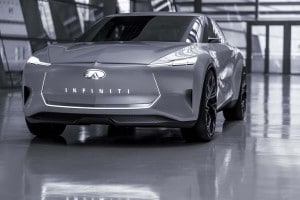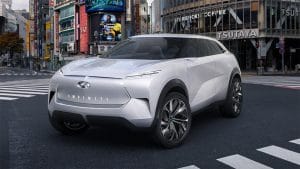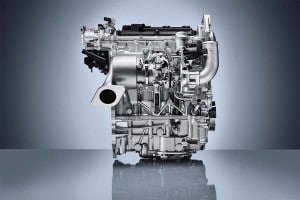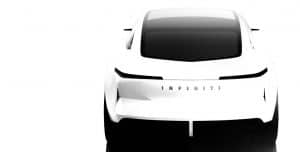
The Infiniti Qs Inspiration – a modern take on the original Infiniti Q45, will be one of the concept vehicles to go electric in production.
Infiniti will launch at least three new battery-powered models over the next several years and they will offer buyers two distinct drivetrain options, company officials confirmed at a background briefing.
Based on an all-new architecture specifically developed for electrification, the three will be based on the Infiniti Q, QS and QX Inspiration concept vehicles that the automaker has shown over the last couple years.
Though final details have not been locked in place, the luxury arm of Nissan Motor Co. plans to offer both an all-electric drivetrain and another that will rely on a smaller battery pack paired with a compact gasoline generator based on the company’s unique Variable Compression-Turbo technology. That system is meant to address range anxiety concerns.
(Infiniti QX30 is one of the many familiar nameplates going away during the 2020 model-year.)
The first of Infiniti’s EV models “will reach our dealerships in production form in the near future,” said Tim Franklin, director of product planning for Infiniti Americas, adding that the brand hopes to “leapfrog our competitors” in the process.
The basic architecture for the three battery-cars will follow the current industry approach, opting to place batteries and motors beneath the load floor in a skateboard-like platform. In turn, there will be two distinct drivetrain designs:

The Infiniti Qx Inspiration, like the other concepts, will offer a choice of two alternative battery-drive systems.
· One will be all-electric, using lithium-ion batteries, though the size of the pack has yet to be determined. But, considering current trends, something on the order of 80 to 100 kilowatt-hours or more, enough to generate range of around 300 miles – though Infiniti could follow Tesla’s lead and offer different battery pack options;
· The second approach pairs a battery pack of around five kWh with a 1.5-liter VC-Turbo engine. Unlike a plug-in hybrid, the package will not be externally charged. In contrast with a range-extended EV like the BMW i3RE, it will seldom run on pure battery power. But the VC-Turbo engine will only serve as a generator, the wheels always driven by its electric motors.
Infiniti will share the gas/electric technology with sibling brand Nissan. The mainstream marque is dubbing the approach e-Power. Infiniti has yet to come up with a formal name.
Both drivetrains will rely on twin electric motors which will give the vehicles through-the-road all-wheel-drive. As for power, “We’re looking at up to 320 kilowatts,” said Franklin, or about 429 horsepower combined. It’s not clear if Infiniti might offer different levels of performance, as Tesla does and which BMW is considering for future EVs of its own.
Infiniti officials stressed that both approaches will offer the distinctive advantages of an electric drivetrain, including the high levels of instant torque. The hybrid system likely will find the VC-Turbo motor heavily “encapsulated,” according to Infiniti officials, in order to make the package about as silent as silent as the pure electric alternative.
The exact size of the battery pack in the e-Power system could be revised by the time the system comes to market, Franklin told TheDetroitBureau.com after the briefing, noting there would be plenty of space under the floorboards for a larger pack. Going with more batteries would have an advantage in some global markets where cities such as London, Paris and Beijing are considering new rules that would allow only vehicles operating in zero-emissions mode to enter central urban areas.
The decision to base the production battery-cars on the Infiniti Q, QS and QX Inspiration models reflects the brand’s decision to push the design envelope while also taking advantage of the benefits of going with a unique, skateboard-like platform that puts most of its key technology under the floor, rather than in a conventional engine compartment.

Infiniti began offering the VC-Turbo — the first production engine that can change its compression ratio — in 2018.
Even with the e-Power approach, the engine compartment will be smaller than with today’s Infiniti models, allowing the product development team to give space back to passengers and cargo.
(Click Here for a first look at the Nissan Ariya EV.)
From a design perspective, the three concept vehicles will likely be tweaked a bit before going into production but are expected to retain their distinctive styling language which, the automaker says, is based on the “Japanese spatial concept of ‘Ma.”
It can be “described as an emptiness full of possibilities, potential and anticipation,” Infiniti explained in a statement about the three concepts, and “will emphasize the smooth, muscular spaces between the sharp, sheer lines of the bodywork, building visual anticipation for the electrified performance within.” Add “body surfaces and creases inspired by origami, the Japanese art of folding paper, and technical ‘kimono fold’ patterns, inspired by the straight lines that typify modern Japanese architecture.”
Inside, the extra space will be used to create “lounge-like interiors,” Infiniti said.
The automaker is not ready to discuss the precise timing for the launch of its new, electrified vehicles but, based on prior comments – and the competitive challenge it faces in the luxury segment – it appears likely the first model will roll into showrooms within the next couple years.
(Infiniti parent Nissan hopes new CEO can help “restore trust and business performance.)


They need to put giant arrows on the sides so we can tell which is the front.